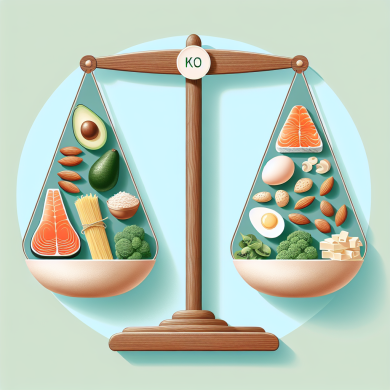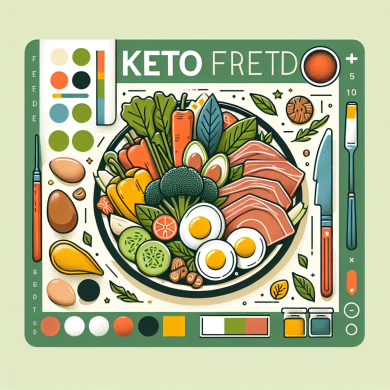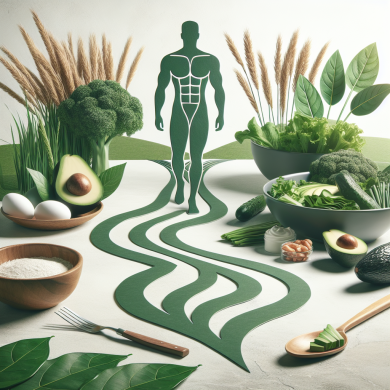Mastering the Vegetarian Keto Diet Guide
“`html
Introduction to the Vegetarian Keto Diet
The ketogenic diet has gained immense popularity due to its potential benefits for weight loss, mental clarity, and overall health. However, the traditional keto diet predominantly relies on animal-based products for protein and fats, which can be a challenge for vegetarians. Enter the vegetarian keto diet – a unique fusion of two dietary approaches that allows individuals to reap the benefits of ketosis without compromising their vegetarian principles. This guide aims to provide a comprehensive overview of mastering the vegetarian keto diet.
Understanding the Keto Diet
The ketogenic diet primarily focuses on high-fat, moderate-protein, and very low-carbohydrate intake. The goal is to shift the body’s metabolism from relying on glucose as the primary energy source to using ketones, which are produced from fat, for energy. This metabolic state is known as ketosis.
Benefits of the Keto Diet
1. **Weight Loss**: By utilizing fat as the primary energy source, the keto diet can lead to significant weight loss.
2. **Improved Mental Clarity**: Many individuals report enhanced cognitive function and focus while in ketosis.
3. **Stable Blood Sugar Levels**: The diet’s low-carb nature helps stabilize blood sugar and insulin levels, which can be beneficial for those with type 2 diabetes.
Challenges of a Vegetarian Keto Diet
Adopting a vegetarian keto diet can present unique challenges, primarily due to the limited food options that fit both dietary criteria. However, with careful planning, it is possible to achieve a balanced and nutritious diet.
Protein Sources
One of the main challenges is finding adequate protein sources. While the traditional keto diet relies heavily on meat and fish, vegetarians can turn to eggs, dairy products, and plant-based proteins like tofu, tempeh, and seitan.
Fat Sources
Fats are crucial in the keto diet, and vegetarians can obtain these from nuts, seeds, avocados, coconut oil, and olive oil. Dairy products like cheese and butter are also excellent sources of fats for lacto-ovo vegetarians.
Carbohydrate Restrictions
Vegetarians often consume a diet rich in grains and legumes, which are high in carbohydrates. On a vegetarian keto diet, these need to be replaced with low-carb vegetables like leafy greens, mushrooms, and zucchini.
How to Start a Vegetarian Keto Diet
Starting a vegetarian keto diet requires careful meal planning and a solid understanding of food macronutrients.
Calculate Your Macros
Understanding your macronutrient needs is crucial. Typically, a keto diet consists of:
– 70-75% of calories from fat
– 20-25% from protein
– 5-10% from carbohydrates
Use a macro calculator to determine your daily needs based on your age, weight, activity level, and goals.
Plan Your Meals
Planning is essential to ensure you are getting enough nutrients. Create a weekly meal plan that aligns with your macro goals. Include a variety of foods to avoid nutritional deficiencies and monotony.
Stock Your Pantry
Having a well-stocked pantry with keto-friendly vegetarian staples will make meal preparation easier. Essential items include:
– Healthy oils (olive, coconut)
– Nuts and seeds
– Cheese and dairy products
– Low-carb vegetables
– Plant-based protein sources
Sample Vegetarian Keto Meal Plan
To help you get started, here is a sample meal plan for a day on the vegetarian keto diet.
Breakfast
– Spinach and cheese omelet cooked in coconut oil
– Side of sliced avocado
– Herbal tea or coffee with cream
Lunch
– Mixed green salad with a variety of low-carb veggies, topped with feta cheese and olive oil dressing
– Grilled tofu or tempeh
Dinner
– Zucchini noodles with pesto sauce and grilled halloumi
– Roasted Brussels sprouts with almonds
Snacks
– Handful of macadamia nuts
– Celery sticks with almond butter
Tips for Success on a Vegetarian Keto Diet
Successfully adopting a vegetarian keto diet requires consistency and dedication. Here are some tips to help you stay on track.
Monitor Your Ketone Levels
To ensure you are in ketosis, consider using ketone testing strips or a blood ketone meter. This can help you adjust your diet as needed.
Stay Hydrated
Ketosis can have a diuretic effect, so it is essential to drink plenty of water and electrolytes to stay hydrated.
Supplement Wisely
Consider supplementing with vitamins B12, D, and omega-3 fatty acids, which can be challenging to obtain from a vegetarian keto diet.
Be Mindful of Hidden Carbs
Always read labels and be aware of hidden carbs in processed foods, sauces, and condiments.
Potential Health Benefits of a Vegetarian Keto Diet
Combining the benefits of both vegetarian and keto diets can offer several health advantages.
Heart Health
A vegetarian diet is typically heart-friendly due to its emphasis on plant foods. When combined with the keto diet’s ability to lower triglycerides and improve cholesterol levels, it can support overall heart health.
Anti-Inflammatory Effects
The diet’s high intake of healthy fats, like omega-3s from nuts and seeds, can help reduce inflammation in the body.
Improved Insulin Sensitivity
Lower carbohydrate intake can improve insulin sensitivity, reducing the risk of type 2 diabetes.
Challenges and Considerations
While the vegetarian keto diet can be beneficial, it is not without its challenges.
Nutritional Deficiencies
The restrictive nature of the diet may lead to deficiencies in certain vitamins and minerals. It is crucial to plan meals carefully and consider supplements.
Social and Lifestyle Challenges
The diet may require significant lifestyle changes and can be difficult to maintain in social settings or when dining out.
Conclusion
Mastering the vegetarian keto diet involves understanding its principles, planning meals meticulously, and staying informed about your nutritional needs. While it presents certain challenges, the potential health benefits and the ability to adhere to vegetarianism make it a viable and rewarding dietary choice for many. By following this guide, you can embark on your journey to a healthier lifestyle while maintaining your vegetarian values.
“`















Add comment